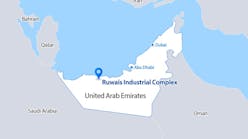ENERGY HUNTER RESOURCES IS THIRD OIL AND GAS START-UP FOR EVANS
ANTHONY D. ANDORA, EDGE CONSULTING, SANTA MONICA, CA
An entrepreneur must be tenacious. They must be driven by passion and desire. They shoulder risk others would never dream to undertake. And, when faced with adversity, they are even more motivated to succeed.
Gary C. Evans, chairman and CEO of newly formed Energy Hunter Resources Inc., is such an individual. He has exhibited all these traits over his 30-plus-year career.
Evans started his first venture in 1985 near the bottom of the oil crash with $1,000 in his pocket. He subsequently built and sold that company 20 years later to Cimarex Energy in June 2005 for $2.2 billion. In 2009, he started his second venture, which focused on unconventional shale. That company saw its revenues soar from $6 million in value to more than $100 million two years later in 2011. However, like so many other companies in the oil and gas sector, that business was eventually dragged down in the current downturn, which has seen historically low commodity prices due to an oversupply of crude oil, gas liquids, and natural gas.
Like many entrepreneurs, however, Evans was undeterred. His committed focus, disciplined approach, and entrepreneurial enthusiasm immediately drove him to his next venture, Energy Hunter Resources. What's more, the same day that Evans departed from his previous company, Magnum Hunter Resources, a Reuters news story ran with Evans announcing the launch of Energy Hunter Resources. Yes, the same day.
When asked what prompted the decision to launch Energy Hunter Resources so soon after his previous endeavor, Evans responded: "There has never been a better time to invest in the oil and gas sector. The downturn has wreaked havoc on asset values. Technical innovation has created tremendous opportunities for margin growth even during a major downturn. And oilfield service costs will likely remain at subdued levels for some time. I doubt I'll ever see an opportunity like this again in my lifetime."
Evans continued, "In fact, there are only a handful of both conventional and unconventional resource plays that are economic in today's price environment. The primary reason they are economic though is because oilfield service costs have come down so dramatically. However, at the same time, technology continues to improve with the ability to drill longer laterals and fracture stimulate more efficiently. Therefore, the ability to generate exceptional cash-on-cash returns currently exists if you are properly positioned."
Evans is not alone in the energy industry with his optimism. Just weeks after launching Energy Hunter Resources, the company announced that it successfully completed a private placement that was oversubscribed by approximately 25%. Use of proceeds from the private placement were initially allocated towards the purchase of two lease acreage blocks located in the heart of the Eagle Ford Shale in Karnes County, Texas. The company further signaled that it has targeted additional acreage blocks in undisclosed locations in the Permian Basin, as well as mineral rights in the Marcellus and Utica shale plays.
As Evans explains, operating and targeting properties in each of these areas is a little like the 1985 movie "Back to the Future":
"This is where it all started for me," Evans said. "Back in 1985 and for 20 years thereafter, we identified high-quality rock properties in the Permian Basin. We grew and built those assets into a multi-billion-dollar company and eventually sold the entire enterprise to Cimarex Energy. And then with my most recent endeavor, the second Magnum Hunter, we acquired contiguous acreage blocks within close proximity to the Eagle Ford Shale. We built and developed those leases and subsequently sold them for $401 million, generating an 80% internal rate of return on our initial investment for our shareholders. And now, here we are again, exploring and acquiring many of those same areas. We will apply new technologies to these fields. We will systematically downspace wells, stay in the zone with computerized geo-steering, and optimize performance, which will allow us the ability to increase ultimate recoveries. And, with seven years of unconventional experience under our belt, we will start to develop and exploit these fields in a highly efficient manner."
Evans added, "I believe our previous experience and knowledge in drilling many wells in those fields provides us with a real competitive advantage. We know the mistakes we made and we also know the successes we had in these fields. We understand the rock properties. And we have access to significant amounts of properly structured capital, as well as valuable long-term relationships in the industry that will provide us with an advantage over many others."
Evans is not alone with his development plans in the Eagle Ford shale and Permian Basin plays. In the past few months, Chevron, Continental Resources, Pioneer Natural Resources, Diamondback Energy, WPX Energy, Callon Petroleum, Parsley Energy, and Concho Resources have told investors they are planning to develop and focus on these core holdings. The emphasis on these fields by some of the most successful operators in the industry suggests that Evans and his new corporation, Energy Hunter, are in good company.
But coming off what is undoubtedly the worst energy downturn in a number of generations, a collapse that pushed nearly one in three domestic oil and gas producers that funded operations with high yield debt into default, according to Fitch Ratings, the challenges remain steep. Moreover, Fitch further estimates that defaults in the sector could rise to $40 billion by year-end 2016. One therefore has to ask, "Are investors prepared to take the plunge back into the energy industry again?"
Recent evidence suggests that they are. This past June, follow-on stock offerings for oil and natural gas companies in North America exceeded $20 billion. This figure surpassed the roughly $19 billion figure in oil and gas follow-on offerings for all of last year, according to a Wall Street Journal analysis.
In addition, on June 22, Centennial Resources became the first oil and gas company in more than a year to file for an initial public offering. And while the subsequent announcement of Centennial's sale of the company to Riverstone Energy will prevent that IPO from taking place, it is yet another sign that investors are returning to the sector.
Even Evans and Energy Hunter Resources acknowledged their desire to access the public markets:
"We have already started to put the pieces in place for a potential public offering of Energy Hunter Resources," Evans shared. "We have retained an investment bank, the principals at which I have worked with for many years, to explore the opportunity and assist us in our next round of capital raising. We are measuring the appetite from investors for such an offering. And, most importantly, we are already building and developing the type of assets capable of generating the kind of returns that investors require today. We are still early in the process but could look to go public in the fall if optimal conditions present themselves."
Whether Evans, a serial entrepreneur and avid hunter as evidenced by his company's name, takes Energy Hunter public this year or not, we will have to wait and see. But after a long downturn in the sector, a downturn that has altered the landscape for so many companies, banks, institutional investors, and individuals, the glimmer of hope we've started to see during the past couple of months has many industry participants and investors cheering for entrepreneurs with the passion, motivation, and vision to return the oil and natural gas industry to its glory days once again.
ABOUT THE AUTHOR
Anthony D. Andora ([email protected]) is president of Edge Consulting, a communications and branding firm that serves the oil and gas industry. With more than 15 years of experience, Andora has consulted, advised, and represented small-, mid-, and large-cap companies on a variety of issues ranging from detailed focus groups, advertising initiatives, investor relations, and national media campaigns. He has co-produced, developed, and placed content in/on CNBC, FOX Business News, Bloomberg Television, The Wall Street Journal, Barron's, and OGFJ.




